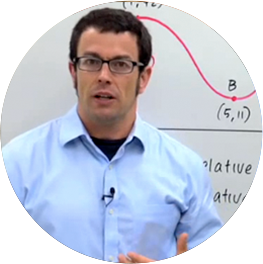
Cornell University
PhD. in Mathematics
Norm was 4th at the 2004 USA Weightlifting Nationals! He still trains and competes occasionally, despite his busy schedule.
The quotient rule is useful when trying to find thederivativeof a function that is divided by another function. As long as both functions have derivatives, thequotient ruletells us that the final derivative is a specific combination of both of the original functions and their derivatives.
I want to talk about another really important differentiation rule called the Quotient rule. The quotient rule is for differentiating functions like this q of x which can be represented as a quotient of two other functions f of x over g of x so how we find q prime of x that's our goal for today.
Well let's start by representing this this relationship between q, f and g as a product so when I multiply both sides of this equation by g of x and I get q of x times g of x equals f of x this is what I'll work with here. Because I already know the product rule and so I can differentiate both sides of this using the product rule now differentiating the left side gives me the first cube x times the derivative of the second g prime plus the second g of x times the derivative of the first q prime and on the right side differentiating just gives me f prime of x so in this equation since I'm looking for q prime, I need to solve for this guy here so I'm going to subtract out this term I get g of x times q prime of x equals f prime of x minus this term minus q of x oops q of x g prime of x and then I have to divide out g of x. Now I've solved for q prime here but I haven't quite I haven't quite finished yet because I would like my answer to be in terms only of f and g I don't want I don't want q in my answer so I'm going to have to replace q of x by f and g in a moment but before I do that I'm going to multiply the top and bottom of this equation by g of x, g of x over g of x now in the bottom that's going to give me g of x quantity squared. In the top I'll have f prime times g of x or g of x times f prime and then I'll have minus q of x times g of x times g prime. Now q of x times g of x let's remember that that's f of x and so we'll make the replacement when I multiply through so let's take this up here again on the left we have q prime of x and multiplying g g of x times f prime I get g of x f prime and I have a minus sign g of x times q of x as I said before that's f of x times g prime and all over, see what we have in the bottom, g of x times g of x we have the quantity g of x squared. This is the quotient rule and it's even better if I write it in terms of f and g, this q of x is f and g so what we're really looking at here is the derivative of f of x over g of x I'll write that this way. The derivative of f of x over g of x is g of x times f prime of x minus f of x g prime of x over g of x quantity squared. This is the quotient rule.
现在我要把一个大盒子,这是一个important rule and I also want to give you guys a way of remembering this rule. And believe it or not this came from a student I was never taught this a student told me this, so when you're taking a derivative of a function that's a quotient to other functions let's call this one the low function and this one the high function. It's low de high minus high de low over the square of what's below. When I say low de high I mean the derivative of the high function so low de high minus high de low over the square of what's below I'll say that in future lessons just to remind you what the quotient rule is.